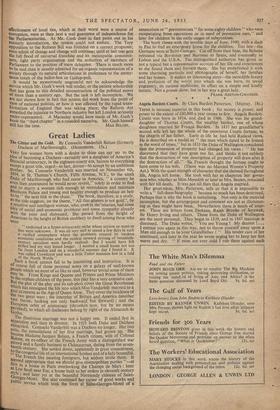Great Ladies
The Glitter and the Gold. By Consuelo Vanderbilt Balsan (formerly Duchess of Marlborough). (Heinemann'. 15s.) Yam' few women born with a desire to shine can say no to. the Idea of becoming a Duchess—certainly not a daughter of America's financial aristocracy, in the eighteen-ninety era, heiress to everything except a great title, urged—in fact, driven—to accept by an ambitious mother. So, Consuelo Vanderbilt was married on November 6th, 1894, at St. Thomas's Church, Fifth Avenue, N.Y., to the ninth 'Duke of Marlborough who had come to America, " a country he even then announced he would never revisit," solely in order to find „and to marry a woman rich enough to recondition and maintain Blenheim Palace and young and healthy enough to produce an heir to he " the next link in the chain." The book, therefore, is a study, as the title suggests, on the theme, "All that glisters is not gold", by a sensitive and intelligent woman, who, even in the 'nineties, had some idea of social and economic problems and some sympathy already With the poor and distressed. She passed from the height -of American to the height of British snobbery to dwell among those who were " enshrined in a hyper-aristocratic niche where sorrow or want or fear were unknown. It was all very well to spend a few days in such a rarified atmosphere where the problems created by modern economic conditions and the restless upward striving of twentieth- century socialism were hardly realised. But I would have felt stifled had my stay lasted longer. I wanted a small house not too far from London and on a wonderful summer day I found it. It was called Crowhurst and was a little Tudor mansion lost in a fold of t North Wold." Such ahe book cannot fail to be interesting and instructive. It is of course full of those personal notes on a galaxy of well-known may which we most of us like to read, however trivial some of them u'aY be. From Kings and Queens and Princes and Prime Ministers P.3 the orphan children of the poor, this play has a very extensive cast. But the plot of the play and its sub-plots cover the Great Revolution Which has consigned the life into which Miss Vanderbilt married to a Past as remote as the Age of Queen Anne. They cover the incidence of the two great wars ; the interplay of Britain and America (another vast theme, looking not only backward but forward) ; and the European orbit of aristocracy (shrunken now, but by no means Perished), to which all duchesses belong by right of the Almanach de Gotha.
The illustrious marriage was not a happy one. It ended first in separation and then in divorce. In 1921 both Duke and Dtichess remarried. Consuelo Vanderbilt was a Duchess no longer. Her two Pas, the consolations of her first marriage, had grown up. She ,name Madame Jacques Balsan, a French citizen, wife of Colonel faiaan, an ex-officer of the French.Army with a distinguished war record and a family business at Chateauroux, dating from the seven- teenth century. She settled down, apparently in great contentment., to [.. „, The congenial life of an international hostess and of a lady bountiful. seettille French like meeting foreigners, but seldom invite them. It d appropriate that we should give cosmopolitan parties —a first in a house in Paris overlooking the Champs de Mars : later at Lou Seuil near Eze, a house built to her orders in eleventh century style ; and later yet at the beautiful Normandy chateau of Saint- Georges-Motel. She also continued her career of good works and public service which took the form at Saint-Georges-Motel of a sanatorium or " preventorium " for some eighty children " who were recuperating from operations or in need of preventive care," and later for children in the early stages of tuberculosis. The book closes with the terrible days or June, 1940, with a dash to Pau to find an emergency home for the children. Too late—the Germans were at Saint-Georges. Cut off from their base, the Balsans retreated via Bordeaux and Bayonne to Spain, and eventually to Lisbon and the U.S.A. The distinguished authoress has given us not a typical but a representative account of her life and experiences as she found them and formed them. She has embellished it with some charming portraits and photographs Of herself, her families and her homes. It makes an interesting story—the incredible luxury and profusion of the world into which she was born, its social pageantry, its curious ambitions, its effect on a simple and kindly nature. Not a grande dame, but in her way a great lady.
FRANK ASHTON-GWATKIN. .


































 Previous page
Previous page